I. Introduction
This paper aims to analyze the political attitudes and characteristics of the ideological “centrist” group, which remains somewhat distanced from partisan and ideological confrontations, amidst the escalating political strife caused by the declaration of martial law by President Yoon Suk-yeol on December 3, 2024.
Political polarization and the subsequent birth of adversarial party politics have led to a state of extreme confrontation between the two institutions of the president and the legislature under a divided government. Ultimately, such bifurcation resulted in the mobilization of military forces by the president and the impeachment of the president by the legislature—both extreme measures—driving South Korea’s political landscape into a state of unprecedented crisis. Though the National Assembly impeached the president in response to the declaration of martial law, partisan conflicts have not subsided. On the contrary, with the Constitutional Court’s ruling on the impeachment looming, tensions surrounding this issue have erupted not only within the political sphere but also on the streets, even leading to extreme acts such as the storming of the judiciary. This paper seeks to examine whether Korean society has become even more polarized due to the martial law–impeachment incident.
Foremost, there must be a rudimentary recognition that President Yoon Suk-yeol’s declaration of martial law was an unjustifiable act, as it went well beyond the legal requirements and procedural legitimacy of exercising such authority and went as far to mobilize the military to incapacitate the legislature. In this sense, the incident represents both a challenge to the constitutional systern and a threat to Korean democracy that transcends partisan interests. Even after the lifting of martial law, however, “Yoon Suk-yeol” remains at the epicenter of partisan conflicts between the ruling and opposition parties, further intensifying disputes among their respective supporters. Despite the seismic disturbance caused by the martial law crisis, the state of polarization that was existent in Korean politics seems yet largely unchanged.
This paper attempts to specifically examine the degree in which the issue of “Yoon Suk-yeol” has divided South Korean society along ideological or partisan lines in the aftermath of the martial law crisis. In particular, it spotlights those who define their ideological stance as “centrist.” While holding a centrist ideological position does not necessarily equate to an absence of partisan preferences (Kang 2007), these individuals are likely to exhibit relatively lower partisan loyalty and ideological intensity compared to those who explicitly align themselves with a specific ideological spectrum. Furthermore, their voices and opinions are often overshadowed in the heated political debates unfolding between opposing factions. This may be due either to their reluctance to actively participate in political discourse or to the overshadowing of moderate voices by the loudly dogmatic opinions of logically extreme and politically active individuals at both ends of the ideological spectrum (Noelle-Neumann 1974). However, if the political preferences of Korean society form a single-peaked distribution centered around moderate voters, rather than a bimodal distribution where the entire population is completely divided into two ideological camps, then the relatively “silent” centrists are bound to play a decisive role in shaping public opinion on critical issues and determining electoral outcomes (Downs 1957).
Although political attitudes are often classified into the binary categories of conservatism and progressivism amid real-world political confrontations, this paper begins with the recognition that various political attitudes exist within these dichotomous classifications. Even within the broad categories of conservatism and progressivism, there are multiple subgroups with differing ideological orientations and intensities. This perspective seeks to move away from conventional interpretations of Korean politics that, under the guise of partisan polarization, have excessively emphasized dichotomous confrontation while neglecting the diversity of political interests within. By focusing on the centrist group, this paper seeks to highlight not only the elements of “difference” and “exclusion” within partisan polarization but also the elements of “similarity in perception” and “possibility of compromise” in political attitudes. The data used in this analysis come from an online survey conducted by the East Asia Institute (EAI) through Korea Research on January 22–23, 2025, targeting 1,514 respondents.
II. Ideological Divergences on Perceptions of the Political Climate of Martial Law and Impeachment
The primary analysis sought to assess respondents’ overall perceptions of the proclamation of martial law and the president’s impeachment, both of which remain subjects of ongoing controversy. As illustrated in [Figure 1], the assessment of President Yoon Suk-yeol’s declaration of martial law is predominantly negative. A substantial 72.7% of all respondents deemed it “wrong”; among them, 58% showcased a particularly fervent critical stance by characterizing the declaration as “very wrong.” Conversely, only approximately 14% of respondents evaluated the proclamation positively. This indicates that, irrespective of political affiliation or ideological stance, President Yoon’s decision to declare martial law is met with widespread disapproval, reflecting a rare point of convergence in public opinion.
On December 14, 2024, the National Assembly passed the motion to impeach President Yoon Suk-yeol with 204 votes in favor, 85 against, 3 abstentions, and 8 invalid votes out of 300 legislative seats. The final decision now rests with the Constitutional Court. An analysis of respondents’ attitudes in this context yet reveals a strong level of public approval for impeachment. A total of 64.5% of respondents expressed support for the impeachment of President Yoon, with more than half—51.5%—stating they “strongly support” the motion. Despite prevailing support for impeachment, however, a significant minority—23.4% of respondents—opposed the motion, with 12.8% stating that they “strongly opposed” it. When compared to the positive evaluation of the martial law declaration, the opposition rate to impeachment is approximately 10% higher. Notably, the proportion of respondents who “strongly oppose” impeachment is roughly twice as high as the proportion of those who “strongly support” martial law.
[Figure 1] and [Figure 2] encapsulate the broader societal climate regarding the martial law crisis. The overwhelming majority expresses a negative evaluation of the declaration of martial law, with three-quarters of all respondents reporting to possess a negative view. This suggests that beyond ideological or partisan preferences, most of the populace perceives the action as a wrongful measure. However, while support for “President Yoon Suk-yeol’s impeachment” is still relatively high, it remains somewhat lower than the negative perception of the martial law proclamation. Moreover, the intensity and proportion of opposition to impeachment are more pronounced compared to responses regarding martial law. This discrepancy underscores the underlying tensions fueling the current political conflict. Specifically, the presence of individuals who hold the ostensibly paradoxical position of “opposing martial law yet rejecting impeachment” emerges as a critical factor exacerbating the political discord surrounding the impeachment proceedings.
[Figure 1] Evaluation of Martial Law Declaration
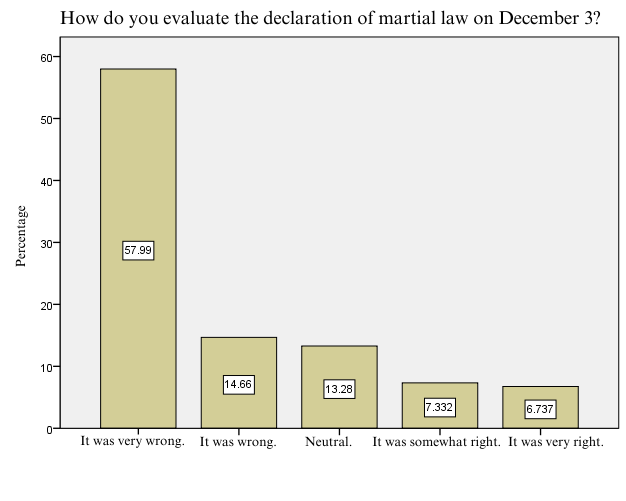
[Figure 2] Position on Impeachment of Yoon Suk-Yeol
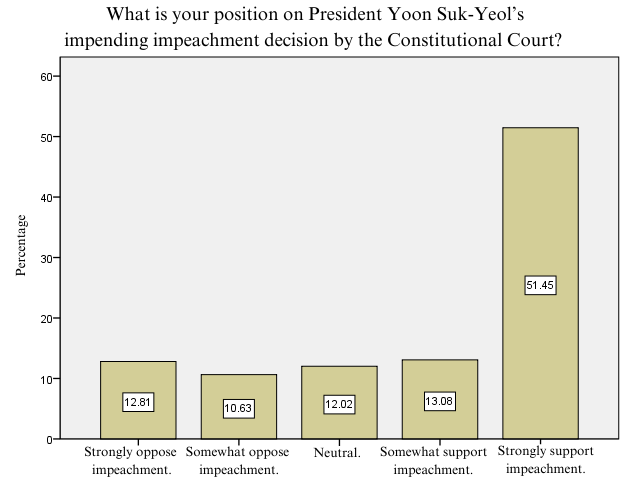
When taking into consideration South Korea’s long record of political polarization, it is comprehensible that responses to the declaration of martial law and attitudes toward President Yoon Suk-yeol’s impeachment varied across partisan lines. With this in mind, an analysis was conducted to assess the correlation between respondents’ perceptions of the two incidents and their choice of candidate in the 2022 presidential election between Lee Jae-myung and Yoon Suk-yeol.
As shown in [Table 1], the results confirmed a clear divergence in positions based on one’s supported candidate. Both sides largely viewed the declaration of martial law as a misstep, with the median score being 3. Even among Yoon’s voters, the average rating was 2.76, indicating a generally negative assessment. Lee’s supporters were even more critical, with an average rating of 1.15, reflecting overwhelming disapproval. Despite a shared negative perception, however, the difference in mean scores between the two groups remained statistically significant.
A clear partisan divide emerged regarding President Yoon’s impeachment. Lee’s voters strongly supported impeachment, averaging 4.8 on a 1-to-5 scale, whereas Yoon’s voters averaged 2.67, slightly below the neutral midpoint of 3, indicating a tendency toward opposition. This disparity underscores the partisan nature of the political conflict surrounding the impeachment.
Regarding President Yoon’s overall governance, Lee’s supporters assigned an exceptionally low average score of 1.73 on a 10-point scale. In contrast, Yoon’s voters provided a more moderate evaluation, generally positioning themselves around the midpoint of a negative-to-positive (-10 to 10) scale.
As illustrated in [Figure 1] and [Figure 2], while public sentiment is largely critical of the declaration of martial law and a significant portion supports impeachment, substantial variations persist based on partisan alignment.
[Table 1] Perceptions on Voting Procedures of the 2022 Presidential Election and the Political Climate of Martial Law and Impeachment
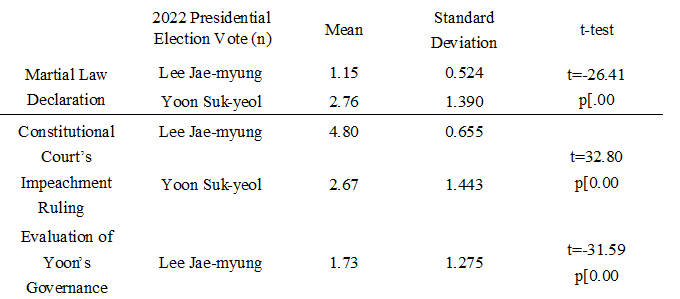
• Impeachment Ruling: 1 (Strongly oppose), 2 (Somewhat oppose), 3 (Neutral), 4 (Somewhat support), 5 (Strongly support)
• Evaluation of Yoon’s Governance: 1 (Very poor) – 10 (Very good)
• n: Lee voters: 594, Yoon voters: 588
The current political conflict can be fundamentally attributed to ideological differences regarding the impeachment of Yoon Suk-yeol. In contrast to the resolute position held by Lee Jae-myung’s supporters, Yoon Suk-yeol voters demonstrate a somewhat opposing perspective on this issue. However, as evidenced in [Table 1], while Yoon Suk-yeol voters generally oppose the impeachment decision, the relatively large standard deviation indicates considerable diversity in viewpoints within this group. This suggests that although the average opinion leans slightly toward opposing impeachment, significant internal variation exists among these voters. Given this variability, a linear regression analysis was conducted to examine Yoon Suk-yeol’s voters’ perceptions of martial law and impeachment. The results are summarized in [Table 2].
[Table 2] Perceptions of Martial Law and Impeachment Among Yoon Suk-yeol’s Voters: Linear Regression Analysis
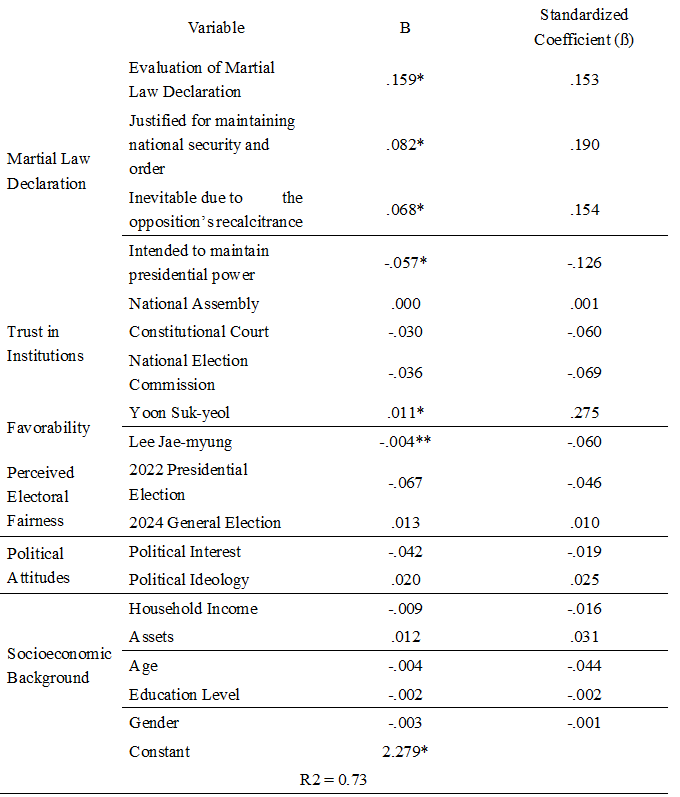
• Dependent Variable: Attitude toward impeachment (1: Strongly Support, 2: Somewhat Support, 3: Neutral, 4: Somewhat Oppose, 5: Strongly Oppose).
o Evaluation of Martial Law Declaration: 1 (Strongly Wrong) – 5 (Strongly Right)
o Justification for Martial Law (National Security, Opposition Recalcitrance, Power Retention): 1 (Not at all) – 10 (Strongly Agree)
o Trust in Institutions: 0 (Strongly Distrust) – 10 (Strongly Trust)
o Favorability: 0 (Highly Negative) – 100 (Highly Positive)
o Perceived Electoral Fairness: 1 (Free and Fair) – 4 (Not Free and Unfair)
o Political Interest: 1 (Not at all Interested) – 4 (Highly Interested)
o Political Ideology: 0 (Most Progressive) – 10 (Most Conservative)
• *p < .001, **p < .05
In [Table 2], independent variables are categorized into six groups: Martial Law Declaration, Trust in Institutions, Favorability, Perceived Electoral Fairness, Political Attitudes, and Socioeconomic Background. Among these, all four variables under the Martial Law Declaration category were found to be statistically significant.
The findings indicate that a more positive evaluation of the martial law declaration, along with the belief that it was necessary for maintaining national security and order or was inevitable due to the recalcitrance of the opposition party, is associated with a higher likelihood of opposing impeachment. Conversely, these respondents did not perceive the declaration as an attempt by President Yoon to maintain his power. This suggests that impeachment opponents include both supporters of martial law itself and those who believe its implementation was justified under the given circumstances.
Additionally, favorability toward Yoon Suk-yeol and unfavorability toward Lee Jae-myung emerged as significant predictors of impeachment opposition. However, attitudes toward electoral fairness and trust in the National Election Commission, which were central to President Yoon’s claims of alleged election fraud during the martial law declaration, were not found to have a statistically significant effect on impeachment opposition among Yoon voters in the 2022 election. Ultimately, opposition to impeachment among Yoon Suk-yeol’s voters appears to be primarily driven by supportive attitudes toward the circumstances that led to the martial law declaration, particularly dissatisfaction with the opposition party.
However, as shown in [Table 1], while Yoon voters leaned slightly toward opposing impeachment, the strength of this stance was not particularly strong. Moreover, the relatively high standard deviation indicates substantial variation in opinions within the group. This suggests that Yoon voters are not a homogeneous bloc and hold diverse perspectives on the issue. The same logic applies to Lee Jae-myung’s voters, who are not necessarily uniform in their political attitudes. Even among those who self-identify as conservative or progressive, variations exist based on ideological intensity, from the moderates to hard-liners, as well as those who identify as centrist.
To account for this variation, respondents were classified into five subgroups: moderate conservatives, hard-line conservatives, centrists, moderate progressives, and hard-line progressives. The frequency distribution of these ideological groups is shown in [Figure 3]. Notably, 46.4% of respondents identified as centrist, making up nearly half of the sample. Additionally, the proportions of moderate conservatives and moderate progressives were nearly identical, as were those of the hard-liners. As illustrated in [Figure 3], the ideological distribution exhibits a symmetrical, unimodal pattern, indicating a balanced left-right distribution.
[Figure 3] Ideological Distribution of Respondents
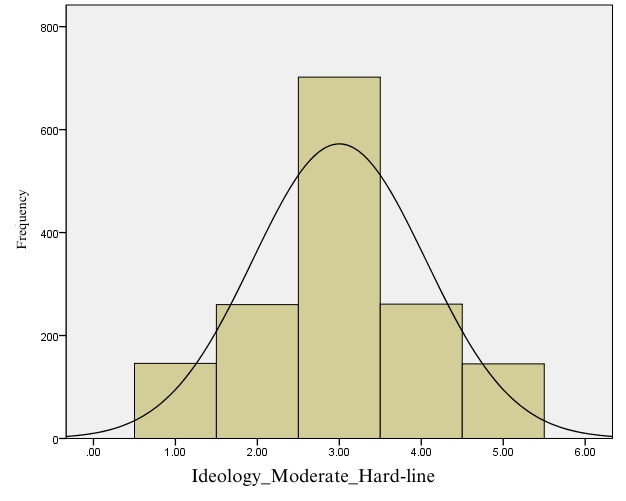

The ideological orientation of centrist voters merits further examination. Even though individuals may identify as centrist, it is not accurate to consider them as completely neutral in terms of partisanship. According to the ‘directional theory’ employed in explaining voting behaviors, the centrist position is neither characterized by a lack of emotional responses nor the paucity of strong directional preferences (Rabinowitz & Macdonald, 1989). In highly polarized political environments, such as recent Korean politics, even centrist voters are compelled to select one candidate over another. Hence, understanding the characteristics of centrist voters requires examining their candidate preferences in the 2022 presidential election.
[Table 3] Supported Candidate in the 2022 Presidential Election by Ideological Orientation

[Table 3] reveals a litany of intriguing results. 92.9% of hard-line progressives voted for Lee Jae-myung, while 91.9% of hard-line conservatives voted for Yoon Suk-yeol. Among moderate progressives, 86.1% voted for Yoon Suk-yeol, and 79.1% of moderate conservatives also cast their ballots in favor of him. These figures indicate that individuals with clear ideological preferences overwhelmingly supported candidates aligned with their respective political affiliations. In contrast, among those identifying as centrist, support for the candidates was nearly equally split, with 49.1% voting for Lee Jae-myung and 50.9% voting for Yoon Suk-yeol. The data presented in [Table 3] underscores the extent of political polarization in South Korea, as individuals with firm ideological stances overwhelmingly supported their respective party’s candidate, while centrist voters were almost evenly divided. Both [Figure 3] and [Table 3] showcase the severity of ideological bifurcation within South Korean society.
To better understand the polarized partisan conflict in the context of the martial law-impeachment situation, it is crucial to examine how each ideological subgroup perceives political leaders and the two major political parties along the ideological spectrum. [Figure 4] and [Figure 5] illustrate the average ideological positions of Yoon Suk-yeol, Lee Jae-myung, and the two major political parties (People Power Party and Democratic Party of Korea) as perceived by voters of Yoon Suk-yeol and Lee Jae-myung, categorized into six groups: hard-liners, moderates, and centrists from each side.
In [Figure 4], hard-line conservatives exhibit an average ideological score of 8.88, positioning them at an extreme end of the ideological spectrum. Notably, while they perceive Yoon Suk-yeol as highly conservative, their own ideological stance is even more pronounced. Despite this, their perceived ideological distance from Yoon Suk-yeol is minimal (0.15), indicating a strong ideological affinity with him. In contrast, they position Lee Jae-myung at 0.54 on the ideological scale, placing him at the far progressive end. Furthermore, they perceive a substantial ideological gap between Yoon Suk-yeol and Lee Jae-myung, with the distance between the People Power Party and the Democratic Party approaching 7. This suggests that, from the perspective of this group, political compromise between the two parties is highly improbable.
In contrast, the moderate conservative group exhibits a comparatively levelled orientation, with an average ideological score of 6.44. They perceive the ideological distance between Lee Jae-myung and Yoon Suk-yeol as 6, and between the People Power Party and the Democratic Party as 5.32, indicating a slightly narrower gap between the two parties than that observed by hard-line conservatives. Notably, they position themselves as more moderate than both Yoon Suk-yeol and the People Power Party, maintaining an ideological distance of 0.88 from Yoon Suk-yeol—a significantly larger gap than the 0.15 observed among hard-line conservatives.
Meanwhile, centrist voters who supported Yoon Suk-yeol (center-right) perceive the ideological divide between the two major parties as even smaller than moderate conservatives do. They estimate the ideological distance between Yoon Suk-yeol and Lee Jae-myung at 4.61 and between the People Power Party and the Democratic Party at 4.1, both of which are smaller than the distances perceived by moderate conservatives. However, centrist voters also exhibit an ideological distance of 1.93 from Yoon Suk-yeol and 1.82 from the People Power Party, suggesting a notable ideological divergence between themselves and the party they supported.
Across all three subgroups, both Yoon Suk-yeol and Lee Jae-myung are perceived as more ideologically extreme than their respective political parties. The People Power Party and the Democratic Party are regarded as comparatively centrist, implying that the public largely perceives political polarization to be attributed to the two leaders rather than the parties themselves.
[Figure 4] Ideological Perceptions of Political Leaders and Parties among Subgroups: Yoon Suk-yeol Voters
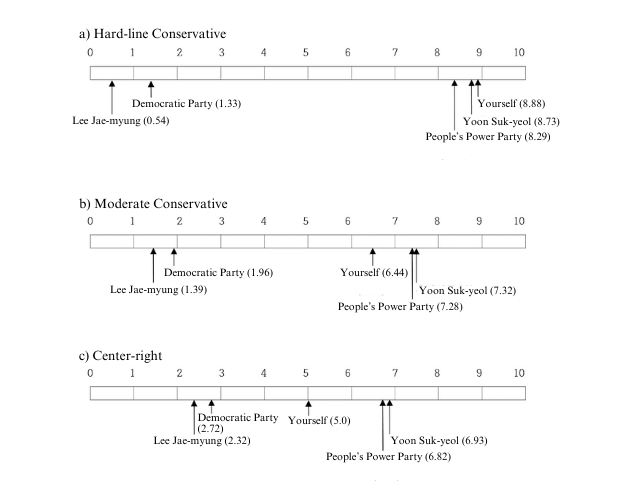
[Figure 5] Ideological Perceptions of Political Leaders and Parties among Subgroups: Lee Jae-myung Voters
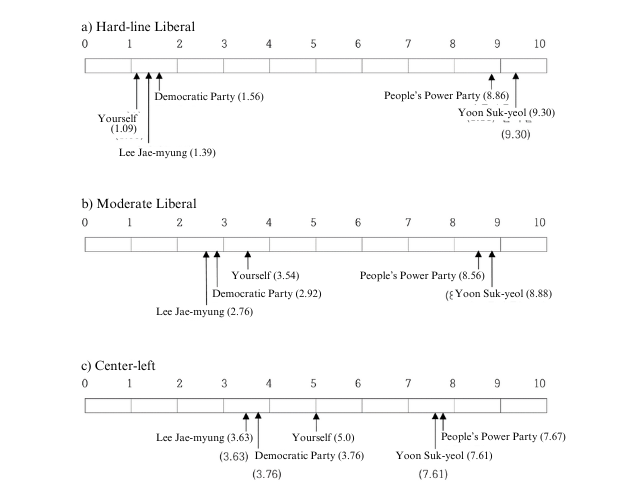
These patterns are similarly observed among Lee Jae-myung voters. The self-identified ideological average of hard-line progressives is 1.09, positioning them at an extreme end of the ideological spectrum. As hard-line conservatives averaged at 8.88, it can be induced that both groups are situated at the far ends of the spectrum; such a state of polarization and the domination of political dynamics by these ideologically rigid groups would make it far more likely that conflicts exacerbate into entrenched opposition.
Similar to hard-line conservatives, hard-line progressives perceive Lee Jae-myung’s ideological position as highly extreme, though at a more heightened degree than their conservative counterparts. They place Lee Jae-myung at 1.39, which is in close proximity to their own position, with an ideological distance of only 0.3. Conversely, they view President Yoon Suk-yeol’s ideological position as extremely conservative, assigning him an ideological average of 9.30. Just as hard-line conservatives regard Lee Jae-myung’s position as 0.54, hard-line progressives perceive Yoon Suk-yeol as positioned at the farthest extreme. Hard-liners, both conservative and progressive, assess the two leaders to be at the very opposite poles of the ideological spectrum. While hard-line progressives perceive the ideological gap between the People Power Party and the Democratic Party as slightly smaller than the Yoon Suk-yeol–Lee Jae-myung divide, it still remains substantial at 7.30, suggesting that they perceive the likelihood of political compromise to be highly unlikely.
The moderate progressives report an ideological average of 3.54. Given that moderate conservatives hold an average score of 6.44, this indicates that moderate conservatives are positioned 1.44 points to the right of center, while moderate progressives are 1.46 points to the left, demonstrating relative ideological symmetry between the two groups. As with moderate conservatives, the perceived ideological distance between Lee Jae-myung and Yoon Suk-yeol is 6.12, while the gap between the People Power Party and the Democratic Party is 5.64, both of which are narrower than those perceived by hard-line conservatives. Additionally, moderate progressives position themselves as ideologically more centrist than either Lee Jae-myung or the Democratic Party.
Meanwhile, centrist voters who supported Lee Jae-myung (center-left) perceive the ideological divide between the two parties as even narrower than moderate progressives do. They estimate the ideological distance between Yoon Suk-yeol and Lee Jae-myung at 3.98 and between the People Power Party and the Democratic Party at 3.91, both of which are reduced compared to the perceptions of moderate progressives. However, centrist voters maintain a greater ideological distance from Lee Jae-myung (1.37) and the Democratic Party (1.24) than the previous two groups, indicating a more pronounced divergence between their own ideological stance and the party or candidate they supported.
Interestingly, this group also evaluated the ideological stances of Yoon Suk-yeol and Lee Jae-myung to be closer to the extreme ends of the spectrum compared to their respective parties. With the exception of the case of the People Power Party among the centrist progressives (where the difference is only 0.06), moderate progressives and centrists perceive both the People Power Party and the Democratic Party to be more moderate than Yoon Suk-yeol and Lee Jae-myung. In voters for both candidates, extreme ideological positions are equally attributed to the two political leaders rather than the parties themselves.
[Figure 4] and [Figure 5] effectively illustrate the characteristics of the ongoing political polarization. Regardless of partisan affiliation, it is difficult to argue that individuals with centrist or moderate ideological positions hold extreme views on the current political landscape. Notably, the centrist group, which constitutes 46.4% of the ideological spectrum—nearly half of the total—demonstrates a tendency to converge toward the ideological center, whether on the conservative or progressive side. Given their political attitudes and perspectives, compromise or agreement between the two major political factions does not appear entirely unfeasible. Ultimately, the current state of extreme polarization and conflict can be attributed to the dominance of hard-liners in shaping political debates and contentious issues, rather than by the centrist or moderate ideological groups. As shown in [Figure 3], hard-line conservatives and hard-line progressives each account for only 9.6% of the population. Together, these extreme positions, comprising less than 20% of the total, are driving the political climate and intensifying national division.
III. Political Issues and Characteristics of Ideological Subgroups
As previously noted, while the respective support bases of Yoon Suk-yeol and Lee Jae-myung may rally around their chosen candidates, they exhibit notable internal divergences in their political perspectives. These differences are particularly pronounced among Yoon Suk-yeol’s supporters, as recent affairs placed them to be on the ‘defensive.’ Given the ongoing debate surrounding martial law and impeachment, it is essential to analyze how groups with varying degrees of ideological intensity within each political faction respond to these issues.
[Table 4] Mean Values by Ideological Subgroup
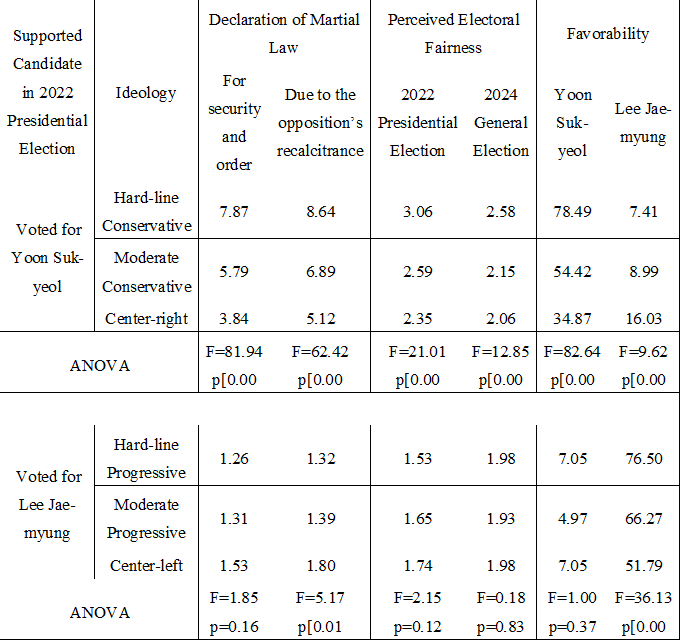
• Electoral Fairness:
1: It was free and fair.
2: It was free and fair, but there were small issues.
3: It was free and fair, but there were significant issues.
4: It was neither free nor fair.
• Scale for Favorability: 0 (Very unfavorable) – 100 (Very favorable)
[Table 4] presents the average values for each ideological subgroup regarding their level of agreement with the justifications for declaring martial law, perceptions of the politically contentious issue of electoral fraud, and favorfavorability toward the two political leaders. Among Yoon Suk-yeol voters, analysis of variance reveals statistically significant differences across all items. In terms of agreement with the two justifications for martial law, support decreases progressively from hard-line conservatives to moderate conservatives to center-right voters. Notably, there is clear disagreement with the claim that martial law was necessary for security and order, and the justification attributing it to the opposition’s recalcitrance received an average score below the median value of 5.5. A similar trend is observed in perceptions of electoral fairness, with significant differences in assessments of the highly contested 2022 general election.
Regarding favorability toward Yoon Suk-yeol, hard-line conservatives report an average score of 78.49, whereas the center-right provide a significantly lower evaluation of 34.87. While moderate conservatives offer a relatively neutral assessment, the favorability rating among center-right voters is notably lower, falling below 50. In the same vein, though Lee Jae-myung receives overwhelmingly negative evaluations from Yoon Suk-yeol voters, center-right conservatives reported relatively higher favorability that was substantially bigger when compared to that of hard-line conservatives.
The findings in [Table 4] indicate that even within Yoon Suk-yeol’s support base, center-right conservatives display substantial differences in political perception and judgment, particularly in contrast to hard-line conservatives.
Conversely, among Lee Jae-myung voters, statistical differences across most items were generally not significant. Regardless of ideological subgroup, there was a strong consensus on trust in electoral fairness and an overwhelmingly low favorability toward Yoon Suk-yeol. However, favorability toward Lee Jae-myung exhibited notable variation. Hard-line progressives rated him highly, with an average score of 76.5, whereas moderate progressives assigned him a score of 66.27, reflecting a 10-point decrease. Center-left voters provided a more neutral evaluation, with an average score of 51.79.
When in respect to the claim that martial law was declared due to the opposition’s recalcitrance, all three subgroups expressed relatively low levels of agreement, though moderate progressives demonstrated slightly higher acceptance. These variations in favorability toward Lee Jae-myung underscore the differing perspectives between his hard-line and centrist supporters.
The subsequent analysis examines variations in trust toward key state institutions, as well as perceptions of martial law and favorability toward the two major political parties, based on ideological intensity within the Yoon Suk-yeol and Lee Jae-myung voter groups. A focus on trust in state institutions is particularly relevant given the significant roles played by the National Assembly, the Constitutional Court, the Election Commission, and the Judiciary in the martial law-impeachment context. The National Assembly initiated impeachment proceedings, the Constitutional Court presided over the impeachment trial, the Election Commission was central to the ‘election fraud’ controversy and the deployment of the military by President Yoon, and the Judiciary is overseeing the trials of Lee Jae-myung.
To explore these relationships, a multinomial logistic regression analysis was conducted, using “hard-line conservative” and “hard-line progressive” groups as reference categories. The analysis categorized variables into four groups. The first pertains to the evaluation of Yoon Suk-yeol’s emergency martial law measures. The second examines institutional trust, specifically concerning the National Assembly, the Constitutional Court, the Election Commission, and the Judiciary. The third assesses favorability toward the two major political parties. Lastly, socio-economic background variables—including age, education, wealth, and income—were incorporated into the analysis.
[Table 5] Differences in Perceptions by Ideological Group: Multinomial Logistic Analysis: Yoon Suk-yeol Voters
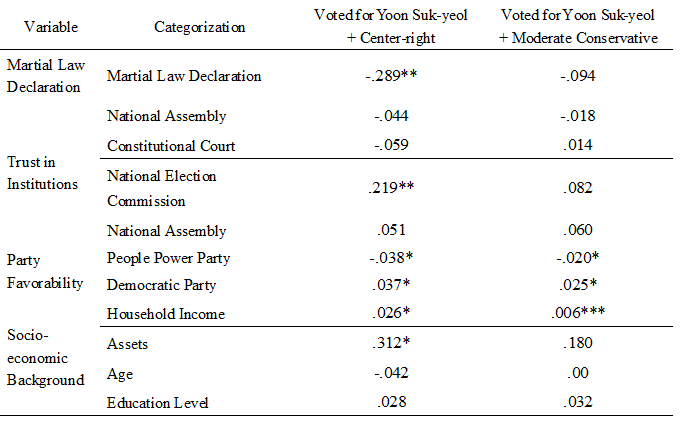
• Center-right (5): 247 (44.9%), Moderate Conservative (6, 7): 178 (32.4%), Hard-line Conservative (8, 9, 10): 125 (22.7%)
• Reference category: “Hard-line conservative”
• *p < 0.01, **p < 0.05, ***p < 0.1
[Table 5] presents an analysis of attitudinal differences among three ideological subgroups within the Yoon Suk-yeol voter group. Compared to the reference category of hard-line conservatives, those on the center-right exhibit significant distinctions across multiple variables.
First, the center-right expressed a higher level of negative evaluation regarding the declaration of martial law. In terms of institutional trust, they demonstrated relatively greater confidence in the Election Commission—an institution criticized by certain conservative factions in relation to the ‘election fraud’ controversy—compared to hard-line conservatives.
Additionally, they reported lower favorability toward the People Power Party and displayed comparatively less negative sentiment toward the Democratic Party than hard-line conservatives.
Furthermore, individuals identifying as center-right tended to be older and possessed higher levels of education than their hard-line counterparts.
Notably, within the moderate conservative group, favorability toward the People Power Party was lower than in the hard-line conservative group. The findings in [Table 5] suggest that the 44.9% of either center-right or moderate conservatives among Yoon Suk-yeol voters exhibit distinct political perspectives and judgments compared to hard-line conservatives.
[Table 6] Differences in Perceptions by Ideological Group: Multinomial Logistic Analysis: Lee Jae-myung Voters
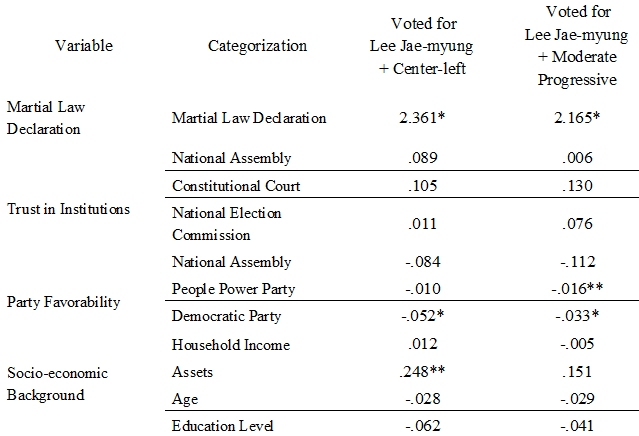
• Center-left (5): 238 (44.5%), Moderate Progressive (3, 4): 179 (33.5%), Hard-line Progressive (0, 1, 2): 118 (22.1%)
• Reference category: “Hard-line Progressive”
• *p < 0.01, **p < 0.05, ***p < 0.1
The same analysis was conducted for the Lee Jae-myung voter group, and the results are summarized in [Table 6]. Compared to hard-line progressives, both moderate and center-left progressives exhibited relatively lower negative evaluations of the martial law declaration, which can be attributed to the exceptionally strong negative evaluations within the hard-line progressive group. An interesting observation for both moderate progressives and center-left progressives is that their favorability toward the Democratic Party was lower than that of hard-line progressives.
In the context of martial law and impeachment, there are relatively few issues on which the progressives would hold divergent views, as there is general agreement that “the declaration of martial law was unjust and President Yoon Suk-yeol should be impeached.” However, the results presented in [Table 4] and [Table 6] reveal a noteworthy distinction in favorability toward Lee Jae-myung and the Democratic Party across ideological subgroups.
To recapitulate, it can be concluded that notable ideological distinctions exist within the conservative camp. The perception of martial law as “inevitable” and opposition to impeachment are positions predominantly held by hard-line conservatives, whereas moderate conservatives—particularly those on the center-right—demonstrate a markedly different stance. Though the progressive camp exhibits less internal divergence on core issues, significant variation is observed in levels of favorability toward Lee Jae-myung and the Democratic Party, suggesting differences in partisan alignment and leader evaluation within the group.
IV. The “Silent” Centrist?
Recent empirical studies have established that ideological subgroups—even when broadly categorized as conservative or progressive—demonstrate heterogeneous perceptions and evaluations regarding contemporary political dynamics. However, the political discourse remains predominantly shaped by more extreme ideological positions. This phenomenon raises a significant question: Why do centrist perspectives maintain limited visibility in public political discourse, and could this be attributable to comparatively reduced political engagement and expression among centrist-identified individuals?
As a systernatic investigation of the question, this study examined dimensions of political efficacy and corresponding levels of political participation across ideological subgroups. Political efficacy has been conceptualized in the literature through two distinct dimensions: internal efficacy and external efficacy. Internal efficacy refers to an individual’s self-assessment of possessing adequate resources and capabilities to influence political decision-making processes. External efficacy, conversely, pertains to an individual’s perception of governmental responsiveness to citizen demands and input. Higher levels of internal political efficacy have been consistently associated with increased likelihood of engagement in various political activities.
[Table 7] presents a comparative analysis of internal efficacy measurements across ideological subgroups. In response to the statement “A person like me cannot influence what the government does,” both moderate conservatives and center-right conservatives demonstrated significantly lower efficacy scores relative to other ideological subgroups. Additionally, on the measure “I am well aware of the key political issues in our society,” both center-right and center-left respondents reported the lowest efficacy levels among all subgroups examined. These findings suggest that centrist-identified individuals generally exhibit comparatively diminished internal political efficacy, with center-right conservatives demonstrating particularly pronounced deficits in this dimension.
[Table 7] Internal Efficacy Measurements across Ideological Subgroups
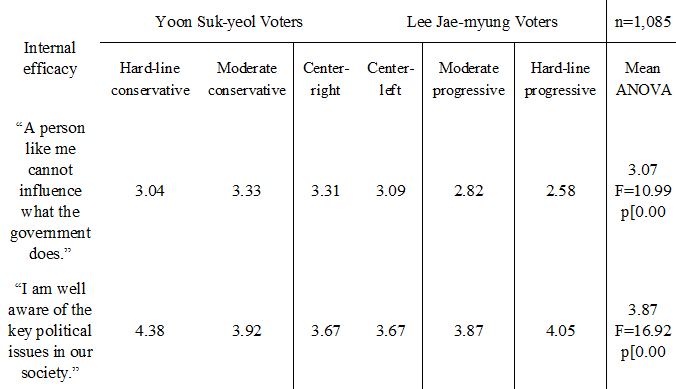
Low political efficacy often correlates with low political participation. To explore this, an analysis was conducted on differences in rally participation—both for and against impeachment—as well as levels of political interest across ideological subgroups. As shown in [Table 8], among progressive groups, moderate progressives reported the lowest levels of participation in pro-impeachment rallies, while among conservatives, moderate conservatives had the lowest participation in anti-impeachment rallies. Moreover, political interest was found to be lowest among those in the ideological middle, regardless of whether they leaned conservative or progressive. In other words, centrist groups demonstrate relatively low engagement with political issues and exhibit more passive political participation. Compared to their more ideologically committed counterparts, moderates remain relatively “silent,” which explains why their perspectives are often underrepresented in political discourse. As a result, political debates tend to be dominated by more extreme and hard-line positions.
[Table 8] Political Participation and Political Interest by Ideological Subgroup
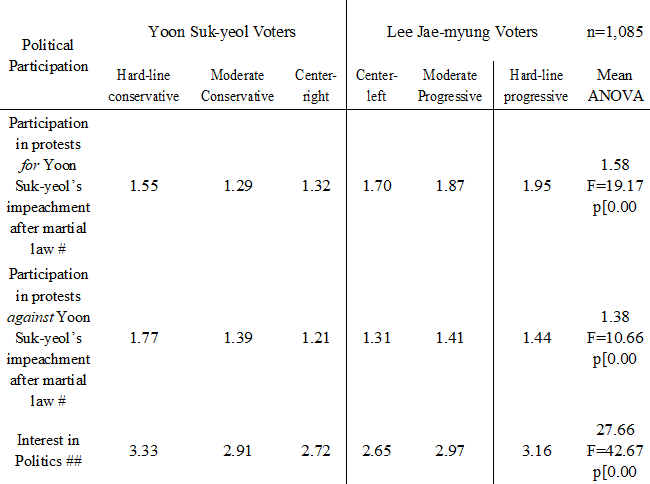
• #1: Never attended, 2: Wanted to attend but didn’t, 3: Attended once, 4: Attended twice, 5: Attended more than three times (n=1,514).
• ## 1: Not at all interested, 2: Slightly interested, 3: Fairly interested, 4: Very interested.
V. Conclusion
This study first commenced with the question of whether the radical politics that has rocked the country since the martial law-impeachment political crisis are accurate reflections of the actual state of South Korean society. Fundamentally, I aimed to examine the validity of the prevalent narrative that society has bifurcated into two opposing factions, with individuals constrained by factional logic, resulting in confrontation between extreme positions.
To address this question, methodology used in this paper included categorizing both conservative and progressive ideological groups into three distinct subgroups—centrist, moderate, and hard-line—and analyzing the differences in political and ideological characteristics among these subgroups. The findings revealed significant heterogeneity in viewpoints within both the conservative and progressive camps. Notably, within the conservative group, a substantial moderate conservative subgroup demonstrated distinct views, perspectives, and assessments that diverged markedly from those of hard-line conservatives. Similarly, within the progressive group, although internal differences were less pronounced due to the nature of the issues examined, there were still observable variations in attitudes toward Lee Jae-myung and the Democratic Party across the subgroups.
This study proved that alternative perspectives and viewpoints well exist within the political landscape, with their proportional representation in the population being actually greater than commonly perceived. However, due to the centrists’ comparatively weak internal efficacy and subsequent lower levels of political participation, today’s political discourse is disproportionately shaped by the extremities voiced by the “politically active minority” that inch further and further away from moderation and rationality.
The seemingly perplexing results of recent public opinion surveys can also be attributed to this “disparity in participation.” The perspectives of extremist groups, who actively engage in political processes, receive excessive representation, while the more politically reticent moderate majority, who tend to abstain from participation, find their views underrepresented. This imbalance yields survey outcomes that fail to accurately reflect genuine public sentiment, resulting in political decision-making processes that are inappropriately influenced by minority viewpoints.
Political deliberations and processes dominated by extreme rhetoric and polarized positions cannot be considered conducive to healthy democratic functioning. There appears to be a compelling need for structural reforms in political communication mechanisms to ensure that the perspectives of the quiescent, moderate, and rational majority are adequately represented in political discourse. ■
VI. References
Campbell, Angus, Gerald Gurin and Warren E. Miller. 1954. The Voter Decides. Evanston: Row, Peterson.
Downs, Anthony. 1957. An Economic Theory of Democracy. New York: Harper & Row.
Elisabeth Noelle-Neumann. 1974. “The Spiral of Silence: A Theory of Public Opinion.” Journal of Communication 24(2): 43-51.
Kang, Won-taek. 2007. “The Characteristics and Significance of ‘Subjective Centrism’ Among Voters in South Korean Politics: Focusing on the 2004 National Assembly Election (In Korean).” National Strategy 13(4): 129-150.
Kim, In-Kyun. 2025. “The Relationship Between the National Assembly and the President in South Korea and the Politics of Budget Deliberation (In Korean).” Ph. D. Diss., Seoul National University.
Rabinowitz G, and Macdonald S. 1989. “A Directional Theory of Issue Voting.” American Political Science Review 83(1): 93-121.
■ Won-Taek Kang is Director of the Institute for Future Strategy at Seoul National University and Chair of EAI's Democracy Research Center.
■ Translated and edited by Chaerin Kim, Research Assistant
For inquiries: 02 2277 1683 (ext. 208) | crkim@eai.or.kr